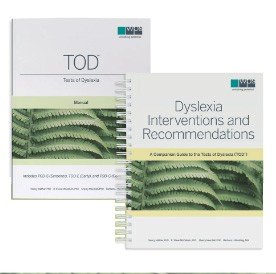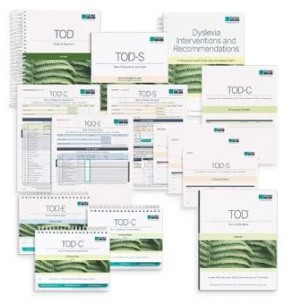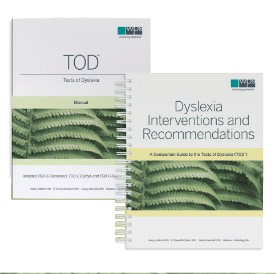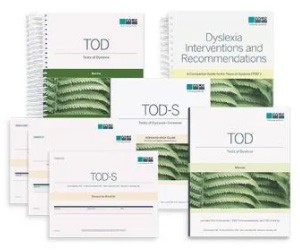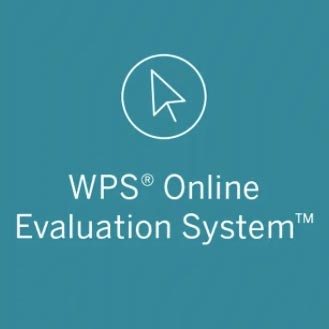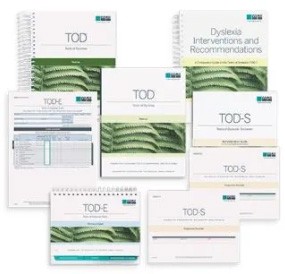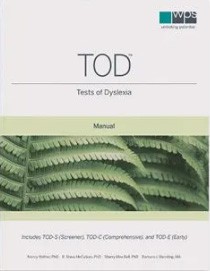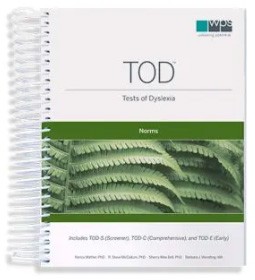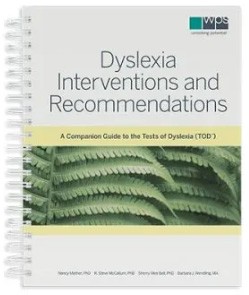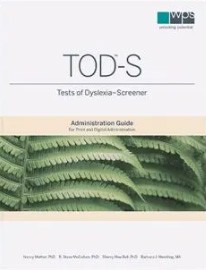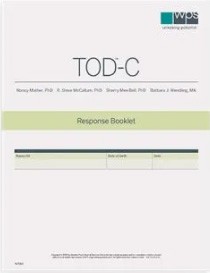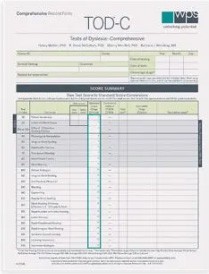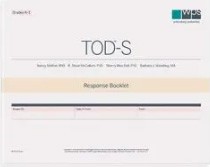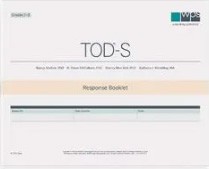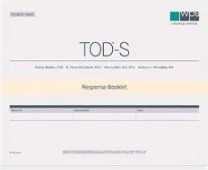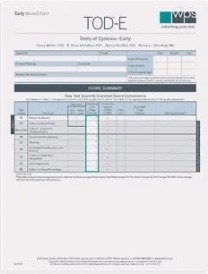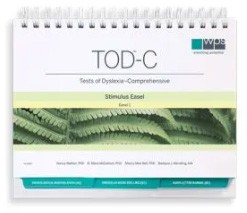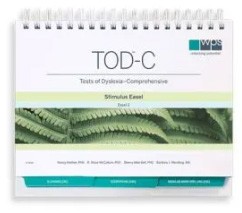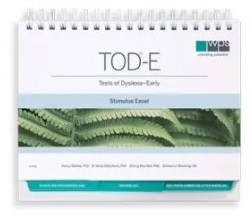The Tests of Dyslexia (TOD) is the first comprehensive assessment of dyslexia, eliminating the need to use tests from different assessments. Linking dyslexia assessment to targeted interventions has never been more efficient and effective.
Assessment areas covered:
- Phonological Awareness
- Rhyming
- Blending
- Segmenting
- Phonics Knowledge
- Rapid Automatized Naming
- Letter and Word Recognition
- Sight Word Acquisition
- Decoding
- Real Words
- Nonsense Words
- Vocabulary Knowledge
- Reading Comprehension & Efficiency
- Reading Fluency
- Spelling
- Reasoning
- Basic Reading Skills
- Listening Comprehension
- Orthographic Processing
- Auditory Working Memory
- Visual–Verbal Paired-Associate Learning
Benefits:
- This is the first comprehensive dyslexia assessment to include interventions tied to the assessment data. Suitable for all ages, the TOD offers age and grade-based tests, indexes, and composite scores:
- TOD-Early (Grades K–2; 5 years, 0 months–9 years, 3 months) - pre-literacy, for children who do not read connected text
- TOD-Comprehensive (Grade 1 through adulthood; 6 years, 0 months–89 years, 11 months)
- The TOD-Screener provides a Dyslexia Risk Index score in 10-15 minutes.
- This brief assessment can be given individually or in a group format by teachers or other professionals.
- The TOD includes:
- a detailed and evidence-based Dyslexia Interventions and Recommendations Companion Guide.
- co-normed rating scales.
- tests of reasoning for comparison with reading and spelling.
- The TOD allows for:
- identification and targeting of an individual's difficulties in acquiring literacy skills.
- universal application regardless of district Specific Learning Disability (SLD) model.
- individually tailored evaluation with standalone tests.
The Tests of Dyslexia (TOD) consists of three (3) sets of direct assessments: TOD-Screener (TOD-S), TOD-Early (TOD-E), and TOD-Comprehensive (TOD-C). The tests measure skills and abilities across three domains: reading and spelling; linguistic processing; and vocabulary and reasoning. TOD Parent/Caregiver, Teacher, and Self-Rating Scales gather data on indicators of dyslexia such as family history of reading problems, motivation, and early speech or language difficulties.
Together, the tests can help you create a profile of reading, spelling, and linguistic abilities to identify those who have characteristics consistent with a dyslexia diagnosis. The Dyslexia Interventions and Recommendations: A Companion Guide to the Tests of Dyslexia (TOD) links assessment data to evidence-based intervention recommendations so you can plan instruction based on individual strengths and needs.
Expanded Scoring Information
Age-based and grade-based standard scores, percentile ranks, confidence intervals, and age- and grade-equivalent scores for each TOD test; Dyslexia Risk Index (TOD-S); Early Dyslexia Diagnostic Index (TOD-E); Dyslexia Diagnostic Index (TOD-C); composite scores in the domains of reading and spelling, linguistic processing, and vocabulary and reasoning; growth scores for monitoring progress. Co-normed TOD Rating Scales provide T-scores, percentile ranks, confidence intervals, and level of risk.
The TOD offers flexible testing configurations, standalone test options, as well as supplemental composites. The TOD-C generates 15 composite scores, and the TOD-E generates 4 composite scores, allowing practitioners to tailor each assessment to the needs of students.
Comprehensive Tests
Decades of reading research have identified the linguistic skills that underlie reading and spelling abilities, as well as those that are typically affected by dyslexia. In alignment with that research, the TOD measures:
- Sight Word Acquisition
- Phonics Knowledge
- Basic Reading Skill
- Decoding Efficiency
- Spelling
- Reading Fluency
- Reading Comprehension Efficiency
- Phonological Awareness
- Rapid Automatized Naming
- Auditory Working Memory
- Orthographic Processing
- Visual–Verbal Paired-Associate Learning
- Vocabulary
- Reasoning
TOD-Screener
This quick screener can be used with individuals or groups to provide a Dyslexia Risk Index (DRI) to show whether a more comprehensive assessment is needed.
TOD-S tests include:
- Picture Vocabulary (not included in DRI)
- Letter and Word Choice
- Word or Question Reading Fluency
TOD-Comprehensive
The TOD-C provides a comprehensive dyslexia assessment which yields a Dyslexia Diagnostic Index (DDI) indicating the probability that an individual has dyslexia. The DDI is based on 2 tests from the TOD-S and 6 additional tests from the TOD-C. Another 14 tests provide a detailed look at skills and abilities related to dyslexia.
TOD-C tests include:
- Phonological Manipulation
- Irregular Word Spelling
- Rapid Letter Naming
- Pseudoword Reading
- Word Pattern Choice
- Word Memory
- Picture Analogies
- Irregular Word Reading
- Oral Reading Efficiency
- Blending
- Segmenting
- Regular Word Spelling
- Silent Reading Efficiency
- Rapid Number and Letter Naming
- Letter Memory
- Rapid Pseudoword Reading
- Rapid Irregular Word Reading
- Symbol to Sound Learning
- Listening Vocabulary
- Geometric Analogies
TOD-Early
The TOD-E assesses each of the early abilities that most clearly indicate dyslexia in young children, yielding an Early Dyslexia Diagnostic Index (EDDI) score. Two TOD-S tests, along with the 6 TOD-E tests, indicate an individual’s risk of dyslexia.
TOD-E tests include:
- Sounds and Pseudowords
- Rhyming
- Early Rapid Number and Letter Naming
- Letter and Sight Word Recognition
- Early Segmenting
- Letter and Sound Knowledge
TOD Rating Scales
TOD-C and TOD-E Parent/Caregiver Rating Scales for grades K through 12 (available in English and Spanish) provide information about:
- family history of reading or spelling difficulties;
- delays in early speech or language development;
- the student’s ability to read, spell, listen, and speak;
- impressions of the student’s abilities compared to others of the same age;
- the student’s attitude toward reading; and
- the amount of support needed for homework and organization.
TOD-C and TOD-E Teacher Rating Scales provide information about:
- the amount of difficulty a student has with reading, spelling, and other classroom tasks;
- whether a student needs extra time to complete assignments;
- how oral language and reasoning skills compare to those of peers; and
- apparent preference for other activities over reading.
TOD-C Self-Rating Scales for Grade 1 through adulthood provide information about:
- attitude toward reading; and
- perception of oral language, word reading, comprehension, and spelling abilities.
Dyslexia Interventions and Recommendations: A Companion Guide to the Tests of Dyslexia (TOD)
This practical, evidence-based companion guide (referred to as the TOD Intervention Guidebook) helps practitioners link detailed interventions and recommendations to assessment data. Based on a structured literacy approach, the guide contains hundreds of strategies and activities grounded in the Science of Reading. It can be used by teachers, clinicians, and families to focus instruction and create a more supportive, effective learning environment.
Use With Variety of SLD Models
The Individuals with Disabilities Education Act (IDEA) describes three methods for identifying dyslexia and other learning disabilities:
- Discrepancy between ability and achievement
- Pattern of strengths and weaknesses
- Response to intervention (RTI)
Although a dyslexia diagnosis should not be based solely on the results of any single assessment, data from the TOD can be effectively used with any of the three IDEA models, subject to the requirements of individual states and school districts.
Comparing vocabulary and/or reasoning composites to reading and spelling composites can provide evidence of discrepancy. For example, when vocabulary and reasoning scores are higher than reading and spelling scores, the difficulties in reading and spelling can be viewed as “unexpected” given verbal comprehension and reasoning abilities.
TOD composites may also indicate a pattern of strengths and weaknesses that is common in individuals with dyslexia: difficulties in reading and spelling, paired with one or more significant linguistic weaknesses, and strong verbal comprehension and/or reasoning ability. TOD composites can be used to confirm such a pattern normatively or intra-individually.
In school districts where students have received evidence-based instruction in a tiered setting, TOD-C standard scores based on national norms can confirm whether a student’s performance and progress are acceptable, or whether a diagnosis of SLD or another condition may be appropriate.
The TOD Manual provides detailed guidance on identifying dyslexia probability using each of these models.
Use in Progress Monitoring
TOD standard scores and growth scores can be used to monitor progress over time. Standard scores are norm-referenced based on age or grade; therefore, achieving the same standard score after a year indicates that a student’s reading scores have increased at the same rate as those of other same-age or same-grade students. Growth scores show an individual’s progress compared to their own previous performance. Growth scores are sensitive to smaller changes, so an improvement of ten points or more indicates meaningful growth in a skill or ability. Used together, standard and growth scores can provide a clear picture of change.
How schools can use the TOD to transform education for students with dyslexia:

 Proud to be Canadian
Proud to be Canadian